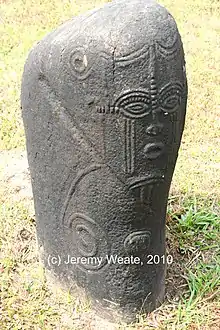Ikom monoliths
The Ikom monoliths are a series of volcanic-stone monoliths from the area of Ikom, Cross River State, Nigeria. Allison estimated that the monoliths may have been engraved between the sixteenth and twentieth century CE.[1]

Description
Numbering about 300 in total, the monoliths are between 0.3 and 1.8 metres (1 and 6 feet) high, and are laid out in some 30 circles located around Alok in the Ikom area of Cross River State. Since Cross River was divided, it now belongs to Akwa Ibom State. The monoliths are phallic in form and some feature stylized faces as well as decorative patterns and inscriptions. Although the carvings have not been deciphered, researchers and linguists believe that the inscriptions may represent a form of writing and visual communication.[2][3]
Conservation risk
Exposure to extreme weather conditions have put these monoliths at risk of erosion and deterioration. The monoliths are also located in an area where the nearby people do not commonly see their worth as tourist attractions. They were added to the World Monuments Fund's list of sites in danger in 2008.[4] In 2020, Ikom monoliths were found by U.S Customs and Border Protection to be coming in to Miami International Airport under fraudulent documents. The artifacts are being returned to Cameroon.[5]
Monoliths in museum collections
A medium-sized example of an Ikom monolith with human facial features can be found in the British Museum's collection.[6]
References
- Hartle, Donald (15 Jun 2011). West African Culture Dynamics: Archaeological and Historical Perspectives. Walter de Gruyter. p. 202.
- Centre, UNESCO World Heritage. "Alok Ikom Stone Monoliths - UNESCO World Heritage Centre". whc.unesco.org.
- "Ikom Monoliths of Cross River State | World Monuments Fund". www.wmf.org.
- "Ikom Monoliths of Cross River State". World Monuments Fund. Retrieved 20 February 2019.
- "Ancient stone carvings found at Miami International Airport". NBC2 News. 2020-10-21. Retrieved 2020-10-22.
- "figure". British Museum.
